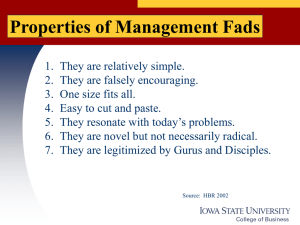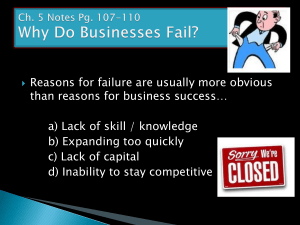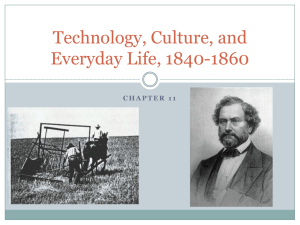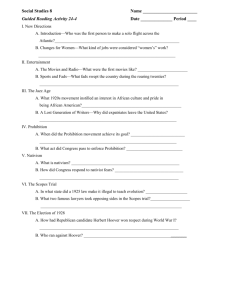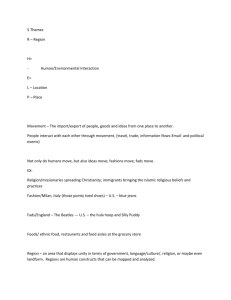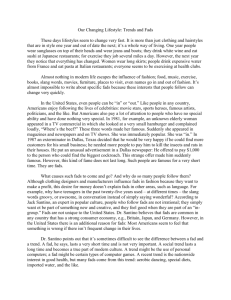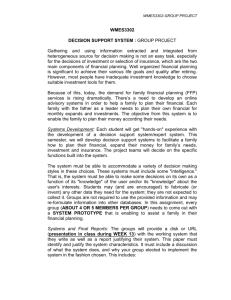SELECTING FINANCIAL ACCOUNTING DATABASES FOR DECISION SUPPORT SYSTEMS DEVELOPMENT
advertisement
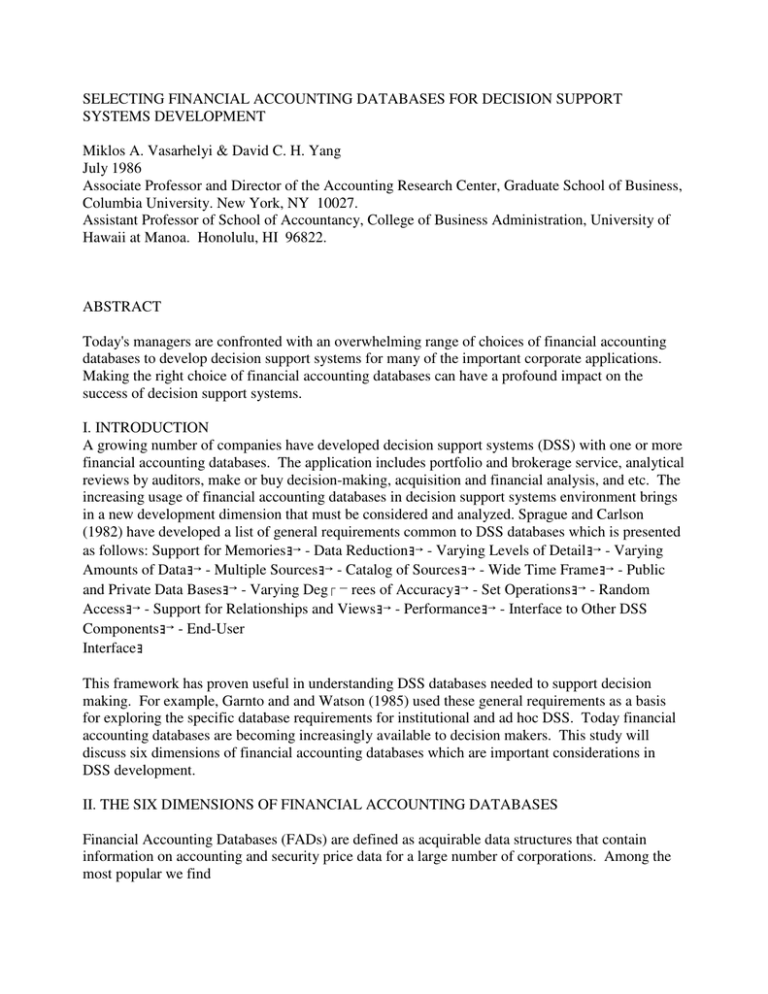
SELECTING FINANCIAL ACCOUNTING DATABASES FOR DECISION SUPPORT SYSTEMS DEVELOPMENT Miklos A. Vasarhelyi & David C. H. Yang July 1986 Associate Professor and Director of the Accounting Research Center, Graduate School of Business, Columbia University. New York, NY 10027. Assistant Professor of School of Accountancy, College of Business Administration, University of Hawaii at Manoa. Honolulu, HI 96822. ٛٛٛٛٛٛٛٛٛٛٛٛٛٛٛٛٛٛٛٛٛٛٛٛٛٛٛٛٛٛٛٛٛٛٛٛٛٛٛٛٛٛٛٛٛٛٛٛٛٛٛ ٛٛٛٛٛٛٛٛٛٛٛٛٛٛٛٛٛٛٛٛٛٛٛٛٛٛٛٛٛٛٛٛٛٛٛٛٛٛٛٛٛٛٛٛٛٛٛٛٛٛٛ ٛٛٛٛٛٛٛٛٛٛٛٛٛٛٛٛٛٛٛٛٛٛٛٛٛٛٛٛٛٛٛٛٛٛٛٛٛٛٛٛٛٛٛٛٛٛٛٛٛٛٛ ABSTRACT Today's managers are confronted with an overwhelming range of choices of financial accounting databases to develop decision support systems for many of the important corporate applications. Making the right choice of financial accounting databases can have a profound impact on the success of decision support systems. I. INTRODUCTION A growing number of companies have developed decision support systems (DSS) with one or more financial accounting databases. The application includes portfolio and brokerage service, analytical reviews by auditors, make or buy decision-making, acquisition and financial analysis, and etc. The increasing usage of financial accounting databases in decision support systems environment brings in a new development dimension that must be considered and analyzed. Sprague and Carlson (1982) have developed a list of general requirements common to DSS databases which is presented as follows: Support for Memoriesョ - Data Reductionョ - Varying Levels of Detailョ - Varying Amounts of Dataョ - Multiple Sourcesョ - Catalog of Sourcesョ - Wide Time Frameョ - Public and Private Data Basesョ - Varying Deg rees of Accuracyョ - Set Operationsョ - Random Accessョ - Support for Relationships and Viewsョ - Performanceョ - Interface to Other DSS Componentsョ - End-User Interfaceョٛ ٛ ٛ ٛ ٛ ٛ ٛ ٛ ٛ ٛ ٛ ٛ ٛ ٛ ٛ ٛ ٛ ٛ ٛ ٛ ٛ ٛ ٛ ٛ ٛ ٛ ٛ ٛ ٛ ٛ ٛ ٛ ٛ ٛ ٛ ٛ ٛ ٛ ٛ ٛ ٛ ٛ ٛ ٛ ٛ ٛ ٛٛٛٛٛٛٛٛٛٛٛٛٛٛٛٛٛٛٛٛٛٛٛٛٛٛٛٛٛٛٛٛٛٛٛٛٛٛٛٛٛٛٛٛٛٛٛٛٛٛٛ This framework has proven useful in understanding DSS databases needed to support decision making. For example, Garnto and and Watson (1985) used these general requirements as a basis for exploring the specific database requirements for institutional and ad hoc DSS. Today financial accounting databases are becoming increasingly available to decision makers. This study will discuss six dimensions of financial accounting databases which are important considerations in DSS development. II. THE SIX DIMENSIONS OF FINANCIAL ACCOUNTING DATABASES Financial Accounting Databases (FADs) are defined as acquirable data structures that contain information on accounting and security price data for a large number of corporations. Among the most popular we find a. COMPUSTAT b. VALUE LINE DATABASE c. Dow Jones News/Retrieval d. CRSP e. NAARSMany corporations are currently in the process of evaluating FADs in DSS development. Previo d. Online vs BatchョッComputer-readable FADs could be supplied as either an online information service (i.e., NARRS, Dow Jones News/Retrieval) or as a periodically updated tape for archival type of usage (i.e., Value Line, COMPUSTAT). Financial vs Non-financial Some FADs (i.e., COMPUSTAT) purely contain financial or accounting information, however, some FADs (i.e., NAARS) also collected other non-financial information. By Area 3) USER SPECIFICATIONS a. Expected Applications Decision makers should identify what decisions to be supported first. Based on the identified decisions, it is possible to select proper FADs. b. Needs of Timely Access How often decision makers need the support of FADs Good support is relative to the time frame of the decision and the time constraints and expectations of the decision makers. Online FADs tend to more expensive; however, online FADs provide more timely information. They created their own FADs which enabled them to have databases made exactly to specifications. See Williams et al. (1985) for a more complete list of financial accounting databases.ٛ ٛ ٛ ٛ ٛ ٛ ٛ ٛ ٛ ٛ ٛ ٛ ٛ ٛ ٛ ٛ ٛ ٛ ٛ ٛ ٛ ٛ ٛ ٛ ٛ ٛ ٛ ٛ ٛ ٛ ٛ ٛ ٛ ٛ ٛ ٛ ٛ ٛ ٛ ٛ ٛ ٛ ٛ ٛ ٛ ٛ ٛٛٛٛٛٛٛٛٛٛٛٛٛٛٛٛٛٛٛٛٛٛٛٛٛٛٛٛٛٛٛٛٛٛٛٛٛٛٛٛٛٛٛٛٛٛٛٛٛٛٛ ٛٛٛٛٛٛٛٛٛٛٛٛٛٛٛٛٛٛٛٛٛٛٛٛٛٛٛٛٛٛٛٛٛٛٛٛٛٛٛٛٛٛٛٛٛٛٛٛٛٛ Needs of Data Retroactivity d. Needs of Data Interface with Other Data and Other Systems Because FADs is only one component of a DSS, it may need to be integrated with other components. Decision makers should consider the possibility of such an interface and related problems. Nature of User and His (Her) Access Needs. Needs for Data Update g. Security and data access needs. Many decisions involve sharing of data, either among six dimensions of financial accounting databases, which should be carefully considered by every organization embarking on a decision support systems development. REFERENCE Garnto, C. and H. J. Watson, "An investigation of Database Requirements for Institutional and Ad Hoc DSS," DATABASE, Summer 1985. Rosenberg, B. and M. Houglet, "Error Rates in CRSP and Compustat Data Bases and Their Implications," The Journal of Finance, Septemb paper is to address significant issues in the evaluation and selection of financial accounting databases. Attention is focused on the six dimensions of financial accounting databases, which should be carefully considered by every organization embarking on decision support systems. ٛٛٛٛٛٛٛٛٛٛٛٛٛٛٛٛٛٛٛٛٛٛٛٛٛٛٛٛٛٛٛٛٛٛٛٛٛٛٛٛٛٛٛٛٛٛٛٛٛٛٛ Most corporations nowadays would probably not be able to afford the costs of gathering publicly available data on their competition with FADs vender companies. As the cost of gathering data skyrocketed, they faced with the decision to select and buy FADs in DSS development. Six dimensions of FADs which are important considerations in DSS development will be presented in this section and some existing FADs will be used as examples. PARAMETERS OF DATABASE Period of Coverage Usually, DSS are intended to help solve a problem which requires looking at data from the past and projecting data for the future. Users should examine the time frame of data gathered, especially in the case of time series studies. For example, Value Line's annual data begin in 1955 and Compustat's annual data begin in 1964.ョョb. Sample characteristics Different FADs contain different set of sample data. For example, the COMPUSTAT database consists Availability Data amounts and items vary among decisions and decision makers. The development DSS begins with the identification of decisions to be supported. Based on the identified decisions, it is possible to specify the information needed by the decision makers. When selecting a FAD the user must consider data's availability. MediumDifferent FADs are stored on differnt media (i.e., diskettes, tapes, floppy disks). Howeve r, users' choice should be compatible with their computer systems.ョョe. Variables IncludedョッUsers will find different data fields and fineness of data among FADs. For example, Value Line contains ASR #190 replacement numbers which are not in COMPUSTAT. Value Line contains some monthly stock price data which are presented in substantially finer detail in the CRSP tapes.ョョf. Data StructureョッThe new FADs should be compatible with the company's other current databases. Problems may occur if the new FADs is not compatible with other current databases; for example, one database is relational and the other database is hierarchical.ٛ ٛ ٛ ٛ ٛ ٛ ٛ ٛ ٛ ٛ ٛ ٛ ٛ ٛ ٛ ٛ ٛ ٛ ٛ ٛ ٛ ٛ ٛ ٛ ٛ ٛ ٛ ٛ ٛ ٛ ٛ ٛ ٛ ٛ ٛ ٛ ٛ ٛ ٛ ٛ ٛ ٛ ٛ ٛ ٛ ٛٛٛٛٛٛٛٛٛٛٛٛٛٛٛٛٛٛٛٛٛٛٛٛٛٛٛٛٛٛٛٛٛٛٛٛٛٛٛٛٛٛٛٛٛٛٛٛٛٛٛ Accuracy If the DSS is to be effective, the data should be accurate. Sound decision making requires that the collected data be accurate. Previous research has shown that data errors tend to be a problem in the large, machine-readable FADs. Rosenberg & Houglet (1974) and San Miguel (1977) suggested that when multiple, computerized databases contain similar information, the data should be matched to verify the accuracy of data. Such! a comparison is not only the most effective way of screening for data errror, it is also the least expensive.ョョh. Verificabilityョョg. Frequency and Reliability of UpdatesョッSome FADs (i.e., NAARS) are typically supplied as either an online information service, oriented towards the terminal based query, or as a periodically updated tape for archival type of usage (i.e., Value Line and COMPUSTAT).ョョh. Cost of AcquisitionョッOne of the important features of a FAD is its direct acquisition and utilization cost. ٛ ウ2..ッ....ッ....ッ..................................................ョsystems, the ongoing maintenance cost, the cost of the computer hardware required to operate the FADs (for example, users must use a NAARS terminal to access NAARS database.), and the personnel costs needed to operate FADs. Annual subscription price for COMPUSTAT is up to $50,000 a year. However, Value Line covers one third as many companies at about a quarter the cost.ョョョ (2) TYPES OF DATABASEョョa. Private vs PublicョッThere are two types" of FADs; either private or public. The former is created by decision makers for their own DSS specifications. The latter is publicly available and acquirable database, and one factor can not be overlooked by the prospective buyer is the financial viability of the FADs vendor.ョョb. Research vs BusinessョッSome FADs were developed from clear research needs, for example, CRSP. However, some FADs have business application values, for example, Dow Jones News/Retrieval and COMPUSTAT.ョョc. Traditional vs Compute decision makers or among operational and DSS applications. However, many decision makers and many decisions require that data be protected from use by others. In the latter case, security control of data access becomes an important issue.ョョョ (4) HARDWARE SUPPORTョョa. Processing Capabilityョョb. Main Memoryョョٛ ٛ ٛ ٛ ٛ ٛ ٛ ٛ ٛ ٛ ٛ ٛ ٛ ٛ ٛ ٛ ٛ ٛ ٛ ٛ ٛ ٛ ٛ ٛ ٛ ٛ ٛ ٛ ٛ ٛ ٛ ٛ ٛ ٛ ٛ ٛ ٛ ٛ ٛ ٛ ٛ ٛ ٛ ٛ ٛ ٛٛٛٛٛٛٛٛٛٛٛٛٛٛٛٛٛٛٛٛٛٛٛٛٛٛٛٛٛٛٛٛٛٛٛٛٛٛٛٛٛٛٛٛٛٛٛٛٛٛٛ ٛٛٛٛٛٛٛٛٛٛٛٛٛٛٛٛٛٛٛٛٛٛٛٛٛٛٛٛٛٛٛٛٛٛٛٛٛٛٛٛٛٛٛٛٛٛٛٛٛٛٛ ٛٛٛٛٛٛٛٛٛٛٛٛٛٛٛٛٛٛٛٛٛٛٛٛٛٛٛٛٛٛٛٛٛٛٛٛٛٛٛٛٛٛٛٛٛٛٛٛٛٛٛ StorageョッThe new FADs should be compatible with the current functioning DSS in terms of storage size, storage devices.ョョd. Communication InterfaceョッCommunication present a different set of problems. For example, NAARS, which contains substantial parts of the text of more than 4,000 financial statements per year, is queried through NAARS/LEXIS terminals which are supplied by Mead Data and limited by key query words and categories. Use rs must use a NAARS terminal leading to major limitations on the integration of its content into a corporate DSS.ョョe. Securityョョョ (5) SOFTWARE ISSUESョョa. Data Organization and Access (DBMS)ョョb. DataMaintenanceٛ ٛ ٛ ٛ ٛ ٛ ٛ ٛ ٛ ٛ ٛ ٛ ٛ ٛ ٛ ٛ ٛ ٛ ٛ ٛ ٛ ٛ ٛ ٛ ٛ ٛ ٛ ٛ ٛ ٛ ٛ ٛ ٛ ٛ ٛ ٛ ٛ ٛ ٛ ٛ ٛ ٛ ٛٛٛٛٛٛٛٛٛٛٛٛٛٛٛٛٛٛٛٛٛٛٛٛٛٛٛٛٛٛٛٛٛٛٛٛٛٛٛٛٛٛٛٛٛٛٛٛٛٛٛ Updates, Purge, Backupョョd. Extraction SoftwareョッData extraction is a technique for interfacing variety of source databases with a DSS database. If decision makers need such a data extraction software to do query, prepare of reports, tables, or do graphs, etc., they should study the availabiltiy of such software which is compatible with selected FADs. ョョe. Securityョョf. User Friendlinessョョg. Analytic Software (SAS, SPSSX, "S")ョッIf decis ion makers need to perform analytic software, for example, SAS, SPSSX, or "S", then decision makers also should examine whether FADs is compatible with the selected analytic software.ョョョ (6) PEOPLEWARE ISSUESョョa. DocumentationョッThe documentation of FADs should be complete and accurate and should be available to decision makers for review before purchase.ョョٛ ٛ ٛ ٛ ٛ ٛ ٛ ٛ ٛ ٛ ٛ ٛ ٛ ٛ ٛ ٛ ٛ ٛ ٛ ٛ ٛ ٛ ٛ ٛ ٛ ٛ ٛ ٛ ٛ ٛ ٛ ٛ ٛ ٛ ٛ ٛ ٛ ٛ ٛ ٛ ٛ ٛ ٛ ٛ ٛ ٛٛٛٛٛٛٛٛٛٛٛٛٛٛٛٛٛٛٛٛٛٛٛٛٛٛٛٛٛٛٛٛٛٛٛٛٛٛٛٛٛٛٛٛٛٛٛٛٛٛٛ ٛٛٛٛٛٛٛٛٛٛٛٛٛٛٛٛٛٛٛٛٛٛٛٛٛٛٛٛٛٛٛٛٛٛٛٛٛٛٛٛٛٛٛٛٛٛٛٛٛٛٛ Training NeededョッTraining and documentation are related capabilities which directly address the process of learning how to effectively use the FADs. Decision makers should examine how much time needed to understand data, to use hardware, if any, and to use software. For example, users will find taking less time to learn Value Line than to learn COMPUSTAT.ョョc. Background NeededョッDecision makers should examine what background needed to#- operate FADs.ョョd. Operation of FADsョョョ III. SUMMARYョョッCurrently DSS are beginning to use externally generated financial accounting information. Managers are confronted with an overwhelming range of choices of financial accounting databases to develop decision support systems for many of the important corporate applications. Making the right choice of financial accounting databases can have a profound impact on the success of a decision support systems. The purpose of this paper is to address significa cial information covering about 6,000 industrial and nonindustrial companies. The Value Line came into being due to the needs of the Value Line Investment Survey and then became a product on its own, which contains over 1,700 major industrial, transportation, utility, retail, bank, insurance and savings & loan companies.ٛ ٛ ٛ ٛ ٛ ٛ ٛ ٛ ٛ ٛ ٛ ٛ ٛ ٛ ٛ ٛ ٛ ٛ ٛ ٛ ٛ ٛ ٛ ٛ ٛ ٛ ٛ ٛ ٛ ٛ ٛ ٛ ٛ ٛ ٛ ٛ ٛ ٛ ٛ ٛ ٛ ٛ ٛ ٛ ٛ ٛٛٛٛٛٛٛٛٛٛٛٛٛٛٛٛٛٛٛٛٛٛٛٛٛٛٛٛٛٛٛٛٛٛٛٛٛٛٛٛٛٛٛٛٛٛٛٛٛٛٛ ٛٛٛٛٛٛٛٛٛٛٛٛٛٛٛٛٛٛٛٛٛٛٛٛٛٛٛٛ ٛٛٛٛٛٛٛٛٛٛٛٛٛٛ Usually the cost factor which is given the most consideration is the initial acquisition cost. Other cost factors also need to be considered, for example, the cost of additional licenses for second and subsequent CPUٛ ٛ ٛ ٛ ٛ ٛ ٛ ٛ ٛ ٛ ٛ ٛ ٛ ٛ ٛ ٛ ٛ ٛ ٛ ٛ ٛ ٛ ٛ ٛ ٛ ٛ ٛ ٛ ٛ ٛ ٛ ٛ ٛ ٛ ٛ ٛ ٛ ٛ ٛ ٛ ٛ ٛ ٛ ٛ ٛ ٛ ٛ ٛ ٛٛٛٛٛٛٛٛٛٛٛٛٛٛٛٛٛٛٛٛٛٛٛٛٛٛٛٛٛٛٛٛٛٛٛٛٛٛٛٛٛٛٛٛٛٛٛٛٛٛٛ ٛٛٛٛٛٛٛٛٛٛٛٛٛٛٛٛٛٛٛٛٛٛٛٛٛٛٛٛٛٛٛٛٛٛٛٛٛٛٛٛٛٛٛٛٛٛٛٛٛٛٛ ReadableョッTraditional FADs are not machine-readable, for example, Standard & Poor's Stock Guide and Bond Guide. Nowadays FADs are mostly stored on tapes, diskettes or floppy disks and they are computer-readable nt issues in the evaluation and selection of financial accounting databases. Attention is focused on the ٛٛٛٛٛٛٛٛٛٛٛٛٛٛٛٛٛٛٛٛٛٛٛٛٛٛٛٛٛٛٛٛٛٛٛٛٛٛٛٛٛٛٛٛٛٛٛٛٛٛٛ ٛٛٛٛٛٛٛٛٛٛٛٛٛٛٛٛٛٛٛٛٛٛٛٛٛٛٛٛٛٛٛٛٛٛٛٛٛٛٛٛٛٛٛٛٛٛٛٛٛٛ er, 1974.ョョッSan Miguel, J. G., "The Reliability of R & D Data in Compustat and 10-K Reports", The Accounting Review, July, 1977.ョョッSprague, R. H. and E. D. Carlson, Building Effective Decision Support System , (Englewood Cliffs, N.J.: Prentice-Hall, 1982), pp. 240243.ョョッWilliams, M. E., L. Lannom and C. G. Robins, Computer-Readable Databases: A Directory and Data Sourcebook , (Chicago: American Library Association, 1985).ョョョٛ ٛ ٛ ٛ ٛ ٛ ٛ ٛ ٛ ٛ ٛ ٛ ٛ ٛ ٛ ٛ ٛ ٛ ٛ ٛ ٛ ٛ ٛ ٛ ٛ ٛ ٛ ٛ ٛ ٛ ٛ ٛ ٛ ٛ ٛ ٛ ٛ ٛ ٛ ٛ ٛ ٛ ٛ ٛ ٛ ٛ ٛٛٛٛٛٛٛٛٛٛٛٛٛٛٛٛٛٛٛٛٛٛٛٛٛٛٛٛٛ
